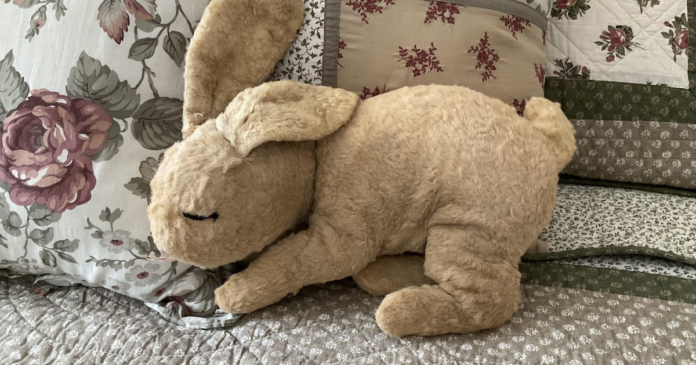The Smithsonian Institution headquartered in Washington, D.C., made up of 21 museums and the National Zoo, is often called the Nation’s Attic because it holds some of the most famous historic artifacts that remind us about the greatness of our country: Abraham Lincoln’s top hat, the desk Thomas Jefferson used to draft the Declaration of Independence and the original flag that inspired the national anthem.
You can also find Fred Rogers’ sweater, Dorothy’s ruby slippers, the Wright Brothers’ plane, the original Spirit of St. Louis that Charles Lindbergh flew during his historic flight over the ocean. Even Kermit the Frog is kept in the institute, and a piece of the moon that you can touch at the Air and Space Museum.
We hold onto artifacts to help us remember who we are and to pass along to those we love the stories that these precious objects represent.
One early morning, my wife, Roe, and I were babysitting our two grandchildren. Their father was at his work at the firehouse, and their mother, a teacher, was on her way to her school. At one point, Roe began making the children’s breakfast and it was my job to go upstairs and wake 6-year-old Finnian. Indigo, who is 3 1/2, goes to school later, so I let her sleep.
When I approached Finn’s bed, there he was: eyes closed, lobster pajamas snug and comfortable, and looped under his arm his brown plush toy rabbit. Well, it was less plush after many years of hopping in and out of a little boy’s tenderness and imagination.
I gently pulled the rabbit from under Finn’s curled arm and then the rabbit began to talk. “Ah, gee, Grandpa. Do you think you ought to wake Finn?” The rabbit began jumping on Finn’s back.
“Well,” I said to the rabbit, “he has to get up for breakfast and school.”
The rabbit bounced gently on Finn’s head. “Hmmm,” said the rabbit. “I don’t think he’s waking up. Any suggestions?”
“I could tickle him,” I answered.
Then I heard a cheeky little boy giggle.
The rabbit bounced right onto Finn’s nose. Finn giggled again, looked up with foggy, groggy eyes, smiled and said, “Hi Grandpa.” Then he reached up for his rabbit.
With both the boy and the rabbit comfortably back in bed, I sat beside Finn and said, “When I was your age I also had a toy rabbit.”
“You did?” Finn asked. Now he was fully awake.
“And actually, I still have him at my house.”
“You do?” Finn’s rabbit asked while jumping all over Finn’s belly. Finn laughed. I laughed. The rabbit laughed, then Finn asked, “Can I see him?”
“Sure,” I said. “When you come to our house on the weekend.”
I gave the rabbit and the boy a hug, and we all laughed as we made our way to the kitchen, where Finn’s breakfast of oatmeal and strawberries waited.
OK. It is one thing to be 74 years old and admit to a 6-year-old that I still have my rabbit from the time I was his age; it is another thing to tell the hundreds of thousands of people who read The Dallas Morning News. Shouldn’t I project a demeanor of cool sophistication?
Maybe it would have been more exciting if Finn’s grandfather flew over the ocean or wrote the Declaration of Independence, but at that moment, Finn was thrilled that, like him, I also slept with my rabbit when I was a boy.
I told Finn how I liked pulling my knees up and curling my arms around my rabbit each night. “Me too,” he said and he showed me how.
How could I have known that keeping a 68-year-old cloth rabbit would have such significant meaning many years later? When I showed Finn my rabbit a few days later, he giggled. “That doesn’t look so good.” But it was the giggles that were precious.
How often do we say that a piece of music or an aroma quickly brings us back to a special place or a special memory? When I hear the song “Greensleeves,” I think of my father, for that was his favorite piece of music. When I inhale a freshly baked apple pie, I think of my mother’s pies that she made using the apples from the tree that stood right outside the kitchen window.
One of my favorite artifacts from my family’s history is the steamer trunk. In the winter of 1948, my mother and father and my two older brothers boarded the famous Queen Elizabeth at Southampton, England, and headed for New York Harbor. They were in the Cunard White Star, cabin class D, and I have the trunk that my parents filled with their dreams for a new life following the devastation of World War II. America was the true land of opportunity that welcomed immigrants with open arms.
I look at the stencils on the trunk: “February 19th: Baron de Vinck.” My father was a true Belgian baron. I have his tuxedo from his days of dancing at many balls in many chateaus from the world of Gatsby and wealth. My family still has in a small white box the long locks of my mother’s blond hair from the days of her teenage years. I think about the tuxedo dancing with the long blond hair a million years ago, but the artifacts linger, and the memories of my parents flicker brightly for a moment.
Rabbits and tuxedos; airplanes and steamer trunks.
We keep dusted memories and polished artifacts from our past to keep us grounded in the present, and to leave behind bits of ourselves in the attic room for our future children to discover and to imagine the valuable stories of long ago.



